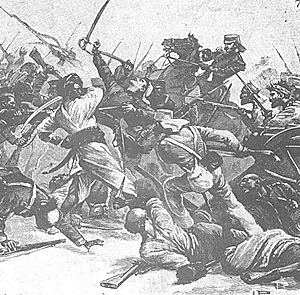
I would like to believe that I conduct my wargaming activities under almost ideal conditions and circumstances. On a reasonable sized table (8' x 5') in a room specifically utilised for war gaming with the armies displayed on shelves around its walls, four of my best friends plus my son and heir gather each Thursday evening to do battle. Dice throws decide who sides with whom and, except in those specific cases where the commander of an army conforms to the temperament of one of my friends, the opposing armies also gain their leaders by Chance.
The battles vary from those involving Roman Legions, Ancient Britons, elephants and the like, through the ages to the Mediaeval period involving my beloved English bowmen, onto Pike-and-Shot periods usually the English Civil War, then to Marlburian, 7 Years War and the American War of Independence. The Napoleonic Wars in their various facets are frequently re-fought as the young Napoleon again triumphs in Italy, the French slog their way through Egypt or my particularly favourite Light Division play a prominent part in recreating the Peninsular War.
Moving ever nearer towards today, we have re-fought the mid-19th century wars in Italy between the Allied French and Piedmontese against the white uniformed Austrians, who have also taken on the Prussians in reconstructions of the Seven Weeks War of 1866. The American Civil War (my first favourite,) has a singular charm that brings it onto the table at regular intervals and then we have a Russian Army of the 1877 period who, for want of a European opponent (alas, I have no Turks) are usually allied to tribesmen in their attempts to force their way through the North-West Frontier of India. Sandwiched somewhere in this period are Desert affairs between the Foreign Legion with native troops and the fierce Touregs or Bedouin Arabs. That much under-rated wargaming period of the two Boer Wars (1881, 1899-1902) is another favourite and there is a fascinating collection of vintage cars and early armoured vehicles who fight a largely fictional war of about 1917 against the Germans in some part of Africa.
Without actually fighting it, the Spanish Civil War has entered our minds with its extraordinary mixture of World War I and the prototypes of World War II equipment plus International Brigades, native troops, Italians, Germans, etc., etc. World War II is not a particular favourite, largely because of the great diversity of guns and vehicles and the difficulty of authentically simulating the firepower of that time.
Missing from the above is perhaps the greatest of all my loves -- Colonial Warfare. Beginning with Indians and settlers in mid-18th century America, we have fought Colonial battles with frontier tribesmen such as Pathans, Ghazis, Afridis and a host of other tribes and races with spine-tingling names; Zulus have assailed Rorke's Drift and ambushed ox-drawn wagons in African drifts. But, favourite amongst favourites are those wargames when khaki and red clad British infantry take on a much undervalued Dervish army which now, thanks to Doug Johnston, are beginning to achieve their true military worth.
The other night, after some seventeen years of such wargaming, a unique situation presented itself. It happened on the North-West Frontier in about 1890, when a brigade consisting of a battalion on the Hampshire Regiment, a battalion of Gurkhas and a battalion of Sikhs, supported by two squadrons of British and Indian cavalry andtwo mule-borne mountain guns, were conducting a punitive expedition against about twice their number of tribesmen; the object of the expedition being to burn the tribesmen'avillage at the far end of the wargames table and then withdraw with the minimum of casualties.
We are rather proud of these rules which give an extremely realistic simulation of this type of warfare - but perhaps they are too good because the wargamers handling the natives became a little jaded at the heavy casualties they sustained from mountain guns and magazine rifles whilst failing to achieve any such casualty rate themselves with their primitive jezails and a few stolen British rifles. Another tribe from a neighbouring village appeared on a flank, making the odds about 212 to 1 but still the natives were cut down and pushed back as the expedition advanced remorselessly towards their mud village. There was no doubt that what was going on was realistic and lifelike in that it authentically resembled what really occurred when a well-armed British expedition took the field in that day and age -- but did it make for good wargaming? We are still undecided whether it might not have been better to unrealistically slant the rules so that the firepower and morale of the natives were artificially raised to give them a chance of achieving something that very rarely, if ever, happened -- wiping out or defeating a British expedition. What do you think about it?
Back to Table of Contents -- Wargamer's Newsletter # 162
To Wargamer's Newsletter List of Issues
To MagWeb Master Magazine List
© Copyright 1975 by Donald Featherstone.
This article appears in MagWeb (Magazine Web) on the Internet World Wide Web.
Other military history articles and gaming articles are available at http://www.magweb.com